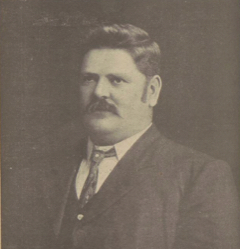
The Australian Natives' Association (ANA) was a mutual society founded in Melbourne, Australia in April 1871. It was founded by and for the benefit of White native-born Australians and membership was restricted to that group.
The Hospitals Contribution Fund of Australia, commonly referred to as HCF, is an Australian private health insurer headquartered in Sydney, New South Wales. Founded in 1932, it has grown to become one of the country's largest combined registered private health fund and life insurance company. HCF is the third-largest health insurance company by market share, and is the largest not-for-profit health fund in Australia.

Sir Arthur Robinson KCMG was an Australian politician, at different times a member of the upper and lower houses of the Victorian parliament and a federal MP.

Thomas Glass was an Australian politician and Chief President of the Australian Natives Association.

John Lemmon was an Australian politician. He served the longest ever term as a member of the Victorian Parliament, being an MLA for over fifty years.

James Liddell Purves QC was an Australian barrister, politician. and a Chief President of the Australian Natives' Association.

Charles Henry Chomley was an Australian farmer, barrister, writer, and journalist. His non-fiction and fiction works alike reflected his strong interest and involvement in politics and law.

Thomas O'Callaghan was an Australian police officer and Chief Commissioner of Victoria Police from 1902 to 1913.
St Mary's Primary School began life as a Roman Catholic co-educational primary day school with single-sex classes located in West Melbourne, Victoria, Australia. The school was part of the parish of St Mary Star of the Sea, West Melbourne.

The Australian is a defunct English language newspaper that was published monthly in Perth, Western Australia, between 1907 and 1908 under the patronage of the Australian Natives' Association (ANA).

Louie Cullen was a British suffragette and hunger striker who emigrated to Australia to continue her feminist activism. She was imprisoned for her activist work, and was awarded a Holloway brooch.

Harriet Christina Newcomb was an English feminist, activist, and educationist. She was a proponent of progressive education and improved teacher training, in both Britain and Australia, and was an active member of the Women's Freedom League.

Joseph William Kirton (1861-1935) was an Australian politician, who after primary school was apprenticed to a trade, worked in the Victorian Post and Telegraph Department, with continued studies he became an Auctioneer and Commission Agent. He served thee terms in the Victorian Parliament and became a Director and the Chief President of the Australian Natives' Association.

Simon Cadden was a farmer, Ballarat pound keeper and Chief President of the Australian Natives' Association while Ballarat was a prosperous and growing city.
Osbert Edrick Wilson was a clerk, poet, author, orator and a Chief President of the Australian Natives' Association.
David John Wheal was a bootmaker, salesman, businessman and a chief president of the Australian Natives' Association.

George Fitzsimmons was a letter server, a clerk and a Chief President of the Australian Natives' Association.

Edward Elliott Roberts was a clerk, administrator, politician and a Chief President of the Australian Natives' Association (ANA).

Walter Skelton was an accountant, businessman, draper, Magistrate, breeder of fine poultry, and Chief President of the Australian Natives' Association (ANA).

Phyllis Le Cappelaine Burke, was an English-born Australian market researcher, housing commissioner, civic volunteer and philanthropist. She studied economics at the University of Sydney, graduating with a Bachelor's degree in 1922. She served for twenty years on the Housing Commission of New South Wales, and supported numerous social reform causes through her voluntary activities. A devout Catholic, in 1943, she founded Altair, a discussion group for Catholic women who were University graduates. She was also a foundation member of the Sydney chapter of the St. Joan Social and Political Alliance.
















